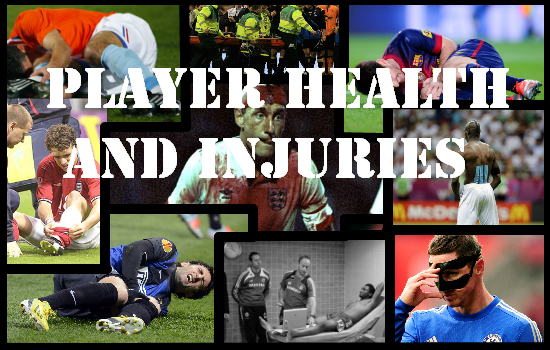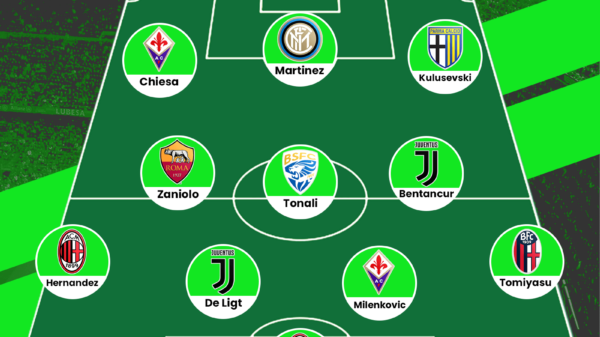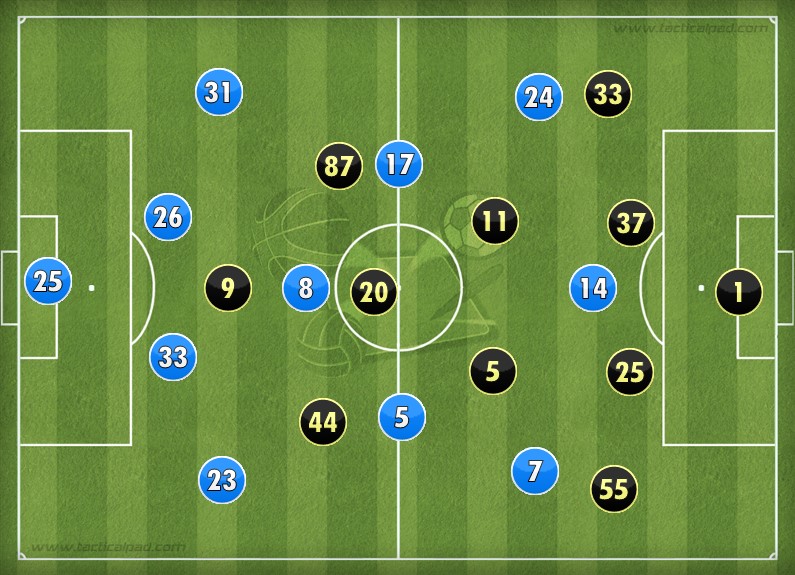Former Internazionale manager Andrea Stramaccioni will tell you the value of having a fit squad. In the 2012-2013 season, the amount of his players contracting injuries was so vast, and those players so vital, he could have almost smiled. In no particular order, poor Stramaccioni lost Diego Milito, Rodrigo Palacio, Antonio Cassano, Esteban Cambiasso, Yuto Nagatomo, Dejan Stankovi?, Walter Gargano, Fredy Guarín, Walter Samuel, Gaby Mudingayi, Joel Obi, Ibrahima Mbaye, Luca Castellazzi, Javier Zanetti, Cristian Chivu, Jonathan and Matías Silvestre to injuries during the tail end of the 2012/2013 Serie ‘A’ campaign – and most were serious. His team were 2nd in the league on the 22nd of December 2012, but only finished 9th after their 38th game on 19th of May, 2013.
The impact of injuries should not be understated in all walks of life. Even the rest of us can often be susceptible to not seeking treatment for our injuries, especially when we have sustained an injury at work. We all say we’ll be fine and sometimes we just brush over it (depending on the severity) but as your health and safety should be your top priority, if you do suffer any injuries at work, it wouldn’t hurt to check out sites like attorneync.com/workers-compensation-attorney/, to get professional advice as to what you should do moving forward. It’s always best accepting help from someone who knows what they are talking about. If you are someone who plays sports regularly, the idea of getting health insurance or at least looking up policies that companies like iSelect offer may be in your best interest. It is better to be safe than sorry. Furthermore, if you have suffered a hand injury it would definitely be worth going to handsurgeonsnyc.com.
This freak, albeit not necessarily unavoidable depletion of the young manager’s match day squad was certain to reduce Inter Milan’s competitiveness, yet it was only Stramaccioni who paid the price. Far from being consoled, Stramaccioni was fired.
This less-than-unique case study begs two questions though – can football players actually stay fit? If not, then why? Johan Cruyff states that in his day, “we never used to do a warm-up. We knew nothing about stretching and we ate whatever was on the table, but we were hardly ever injured.” Why has this changed? Professional football players put their bodies through a lot more trauma in modern football, and this is far from Stramaccioni’s fault. Injuries, as Stan Conte, head of Medical Services at the US baseball team the Los Angeles Dodgers says, are, “sort of like the weather – everybody talks about it, but nobody seems to do much about it.”
It’s difficult to place exactly which aspect of player well being football is worse at treating, but the case of injury recuperation requires immediate attention. When Thierry Henry was knocked semiconscious during the World Cup final in 2006 he had a few blasts of some sniffing salts, a pat on the behind and he was back on the pitch. The Frenchman almost certainly suffered a mild concussion for which we will never know if he was granted sufficient time to recover. It was undoubtedly a bad idea to send him back onto the field. Lionel Messi’s cameo against Paris Saint-Germain in the second leg of the 2012/2013 Champions League quarter-finals is another high profile illustration. Football is littered with these examples. Players are simply not given enough time to recover in the sport.
It might sound self-explanatory, but one of the best ways to recover from a sports injury is bed rest. Correspondingly, sleep plays a crucial role in injury recovery. Whether you are dealing with a muscle strain, damaged tendon, or bone injury, sleep is key to getting your body back in top form. Muscle and tissue repairs and rejuvenates as we sleep, and therefore if you are not getting a sufficient amount of rest each night, it is much harder for your body to bounce back from an injury. Ultimately, if you want to get better as quickly as possible, you need to give your body time to heal. One way to enhance your recovery process is by investing in the best quality high end mattress. Above all, a well designed mattress can make the recovery process much smoother.
It is also important to look at sports other than football too. In the discipline of mixed martial arts (or UFC) in America, a sport where participants literally repeatedly punch and kick each other as hard as they can for the duration of a bout, utilising grapples, holds and heavy impact blows, any concussion – ANY concussion – leads to an immediate 3 month ban and they then have to be cleared by a doctor to come back. As Dana White, President of UFC, proudly reveals “In the 20-year history of the UFC, it will be 20-years in November [2013], there has never been a death or a serious injury. Never been a death or serious injury in 20 years because we go above and beyond when it comes to the safety of these guys. When you know you have two healthy athletes getting ready to compete, they get the proper medical attention before and after, it’s the safest sport in the world, fact.” Football just doesn’t come close to this. The industry now is bulging with individuals who do not have sufficient rest after injury and often play in spite of it, with painkilling injections, bandages, face masks, and fluorescent Kinesio tape. Football journalist Gabriel Marcotti adds to the argument , ‘if a postman twists his ankle, he’ll probably be on crutches for several weeks. If Rio Ferdinand does it, he’ll be back in training after a few days and back on the pitch a week later”. If any strides are going to be made to reduce injuries to players, longer recovery time after an injury needs to be given.
At the moment, there are three main obstacles as to why football simply doesn’t give its players time to recover, that need to be overcome.
Firstly, some of it has to do with the very English, very working-class attitude of ‘getting on with it’. Football players are seen as the very antithesis of the poverty-stricken workers in the industrial revolution, the individuals who instilled this social mentality, where missing a day of work meant missing out on food and medicine for you and your family, often for days, so the very least footballers could do when they hurt themselves is to shut up and get on with it in the same manner as their ancestors, right? Wrong. Football players need more rest and recovery time and this simply isn’t being given to them. We now know more than enough about the body to ignore this archaic mind set. ‘Getting on with it’ has seen so many football players suffer horrific recurring injuries.
The ‘getting on with it’ mentality can lead to horrendous consequences, as demonstrated by US athletes during the Atlanta Olympics in 1996, presumably reinforced by being on home soil. Jane Leavy, reporting in Sports Illustrated, details how a young American gymnast named Kerri Strug became injured after her first vault during the games when, “her left ankle gave way. “There was such momentum,” she [Strug] says, “the bone was shoved forward and then back in place,” tearing the medial and lateral ligaments.” Even so, Kerri had to complete a second vault with the shattered ankle to guarantee a gold medal for her country which, unbelievably, she did. The cost? She had to retire as an athlete shortly after the games. Similarly Kurt Angle, current professional wrestler and former amateur Olympic wrestler fractured two of the cervical vertebrae in his neck before the Atlanta games, and still competed and won gold in 1996. By his own admission he became addicted to a painkiller known as Vicodin as a result.
So, the image of Paul Ince or Terry Butcher with a bloody bandage doing little to prevent the constant flow of blood pouring from their heads, far from the accepted rite of passage for any aspiring England captain, is a failure in attitude toward player health. Football players often nurse injuries and delay any required surgery or treatment until a suspension or even until pre-season. Whilst playing on with painkilling injections is commonplace in football, it’s the wrong thing to do for the player and the club.
The second reason recovery time is so unhelpfully short is the player. If you’re Thierry Henry in the World Cup final or Lionel Messi, who visibly rocked and tapped his feet in nervous excitement waiting to come onto the pitch against PSG, then you want to play. Players need to be more honest with their managers and doctors and inform them what hurts, where it hurts, and why they shouldn’t play. Some of the reasons why they don’t no doubt ties in with the ‘get on with it’ notion. Players have to stop hiding their injuries from their medical staff.
The third reason is the product. The club don’t want a player’s absence to effect their team’s performance, á la Stramaccioni’s nightmare, and the fans want to see the best players all the time. This pressure creates a huge demand for Messi and Henry to get back on the pitch against PSG and Italy respectively, and have a hand in turning the result. It has a huge positive effect on television, media and supporters alike, but Lionel Messi only made his injury worse, and was noticeably affected in the next round of the tournament where Barcelona were eliminated.
All this considered, another area that needs improvement is injury prevention. Injury prevention is much better than injury recovery, but not perfect. FIFA ban tracking and monitoring equipment on players during competitive matches, and you have to feel this removes the ability for clubs and medical departments to monitor players during an entire season of competitive fixtures. Of course, monitoring technology is often utilised in training environments, but this only goes so far. Health analysis in training though, is advanced, and can give clubs on accurate impression of a players match day levels. David Tenney, Head Fitness Coach of the MLS team the Seattle Sounders, reveals how this is done using software called Omega Wave, which specialises in fitness monitoring, “one of the relatively unique things about soccer is that the match is by far the heaviest load or outlay for that particular week. You can use questionnaires and other things, but Omega Wave becomes a critical piece when you really need to quantify each individual’s response to that very heavy load. The day after the game, the players will do the Omega Wave test with a set of five electrodes and a full EKG (electrocardiography- heart rate monitoring), some heart rate readings, and we get a pretty good sense just based on that sort of data for a player.”
There are clubs that seem to have much fitter squads than most ,which implies there is a way of avoiding a long list of absentees. Glen O’Driscoll, who works as Head of Performance under Brendan Rodgers at Liverpool FC has won deserved praise for his approach to keeping players fit. O’Driscoll states, “Each individual player has individualized recovery sessions. In sessions leading into games, we also modify training so they are fresh and well prepared. That’s pretty unique. We determine that based on the individual player and lots of variables go into that. Each individual player has a different injury history so a lot of the individual care, screening, therapy and conditioning that we bring in depends on that player and the injuries he has had in the past – we prioritize and focus on those areas.” However, the attitudes at Liverpool and Seattle, as O’Driscoll implies, are not commonplace. Astrid Junge and Jiri Dvorak illustrate in their paper ‘Injury surveillance in the World Football Tournaments 1998–2012’ that, “a total of 3944 injuries were reported from 1546 matches, equivalent to 2.6 injuries per match“, in their study of World Cups and international tournaments between those years. It showed, “on average, 1.1 injuries per match were expected to result in absence from a match or training.” There is still a long way to go in injury prevention therefore. For every Liverpool FC 2012/13 campaign there is a season like the one Inter Milan had, who could not seem to keep their players fit. Even clubs such as Inter Milan’s city neighbours AC Milan, who have a laboratory dedicated to player fitness, don’t seem to be able to enhance fitness in their team. A massive spate of long-term injuries at the club left many players disillusioned and Alexandre Pato, a former AC Milan player, decided to leave the club in part because he believed he could get better physical treatment in his native Brazil.
Players are playing a huge price for all their professional traumas. Football players have lower life expectancies than average males, and an increased likelihood of contracting serious illnesses such as motor neuron disease and dementia too. As Gianluca Vialli states “Sport is good for you. Professional sport not so much.”
Clubs are paying a financial price too. An enormous one. Most players wages are honoured during lay-offs, and specialist treatment is rarely cheap. To use Inter Milan as a further example (who are taking a real battering here!), the collective value of missing players in their aforementioned ill-fated campaign was just shy of £100million. They also missed out on Champions League qualification and prize money from descending 7 league positions. These collective costs are so frightening, you almost wonder why clubs seem so befuddled by injuries, and don’t do more about reducing them. Money can also be wasted when players purchased do not return from injury to perform as well as they had done prior to the treatment.
If the attitude to physical injury is left wanting, then mental health has almost no consideration in football whatsoever, yet remains just as important an issue to the players, and just as conducive to their level of output on the field. Football as an industry shows a frightening disregard for mental health issues.
Los Angeles Galaxy captain Landon Donovan recently returned from a break from the game because of his mental well being and spoke out about football’s bizarre rejection of the importance of mental health, having hopefully overcome his own problems of ‘burn out’, “We have a sort of stigma that being in a difficult mental place is not acceptable. We should ‘pull ourselves up by the bootstraps’ and ‘fight through it,’ and all this, and it’s a little peculiar to me, that whole idea, that if someone’s physically hurt, we’re OK with letting them take the time they need to come back, but if someone’s in a difficult time mentally, we’re not OK with letting them take the time they need to come back. Hopefully, there’s at least a few people out in the world that can relate to this and can somewhat be inspired.” Football HAS to care more about what is going on in a players mind. It seems appropriate to remind everybody of the case of Robert Enke at this point too.
When Adriano, former Brazil international and ex-Parma and Inter Milan player lost his father and started to drink as a result, he was criticised, ridiculed, and accused of being overweight. Yes, Adriano was a professional football player, but he was first and foremost a human being, who needed help from his clubs to overcome a mental health problem. At the time of writing Adriano has no club at all, such is football’s rejection of the issues surrounding mental health.
Let’s talk solutions then. There is hardly many better solutions than reducing the amount of games professional footballers play. This would lead to a reduction of impact, and a massive reduction in injuries. Dvorak and Junge state, ‘the majority of injuries (80%)[were] caused by contact with another player, compared with 47% of contact injuries by foul play.‘ Reducing the amount of time contact with other players can occur would see a significant drop in injuries. Less matches means less money to clubs however. Although a higher standard of football would inevitably be produced, seeing a desirable 30-game-a-season-only leagues spring up around the world would have club’s bank managers tearing their hair out. Most domestic cups also have such cherished places in fans hearts, scrapping them to protect players who are seen by many as overpaid would really cause an issue for supporters too. More substitutes then? This idea is more practical. The amount of substitutes has steadily risen since they were first introduced, with the increase from 1 player quickly increased to 2 and then 3 over the decades, so why not allow 4 or 5? This would reduce playing time for football players over the course of the season, and aid recovery and prevention too. It would also provide some addition tactical solutions for managers however, which may or may not be a good thing.
Either way, football would do well to come up with something. Between Cruyff eating whatever was on the table and Andrea Stramaccioni’s bad luck something has changed. The more footballers become athletes, the more they need to be treated like them (although preferably not Atlanta 1996 athletes!). Mind sets need to change in relation to injury prevention and recuperation so that we can breed healthier players, who do not then go on to have less years on the planet than everybody else. How is it that something as brutal and unforgiving as UFC has such a significantly better outlook towards its participants health-wise, than the number 1 sport in the world? As shown, clubs have a financial obligation to finding out how to keep their players in better condition, if the moral and ethical obligation doesn’t interest them. The more healthy players are, physically and mentally, the better the football they produce will be.
Also, selfishly, keeping more players fit would certainly make playing fantasy football less complicated as well.

























































